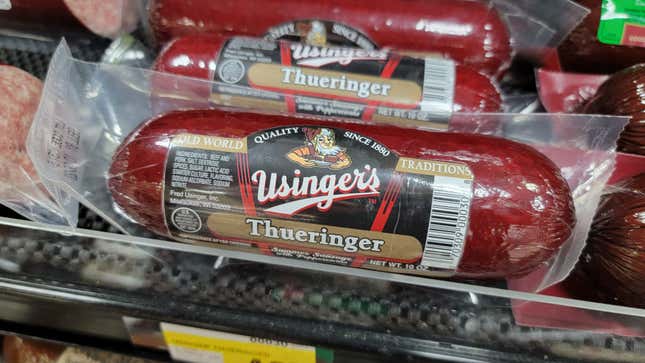
Sausage is like culinary magic: You take a bunch of scraps, leftovers, and otherwise unappetizing ingredients, grind them up with a few spices and stuff them into the unmentionables of various quadrupeds, and what you’re left with is one of the tastiest, most versatile, and best-loved foodstuffs on planet Earth.
But as with any form of sorcery, sorting through the names of the various recipes and incantations can be a tricky business. In fact, the sausage I’ll be discussing today sounds like it comes straight from Dungeons and Dragons: Thuringer, Archmage of the Realms Beyond.
Okay, so I added the last part. But in all seriousness, I’ve recently fallen under the spell of this particular pork. On the surface, it bears a striking resemblance to the summer sausage you’ll find at most major U.S. grocers. Yet, if thou wouldst like to live deliciously, Thuringer has the added bit of kick that can elevate your perception of sausage to a higher plane.
What is Thuringer sausage, and where did it come from?
As with so many foods bearing a geographically protected status, the terminology and rigid attitudes surrounding Thuringer quickly becomes complicated. In short (and at risk of massively oversimplifying), it’s a brat-like sausage originating in the German state of Thuringia.
According to a 2007 article by the Washington Post, “Thuringian bratwurst is distinguished from the other 41 varieties of German bratwurst mainly by its distinctive spices (marjoram, garlic, sometimes a bit of lemon) and its fat content (only 25 percent, compared with up to 60 percent for greasier cousins). It’s also supposed to be cooked and eaten within 24 hours after it is stuffed in the casing.” Sounds delicious! But as much as I adore all things bratwurst, that’s not what we’re here to discuss.
In the U.S., most Thuringer sausage is sold in the form of a cervelat, another complicated word whose meaning depends on geography. In some parts of Europe, cervelats are more akin to a natural-casing hot dog, though the German and American variants provide essentially the same smoked flavor, semi-dry texture, and pre-cooked nature that you’d expect from a typical summer sausage.

So, we’ve established that German cervelats are similar to American summer sausage (though Germany’s Thuringer is more like a brat), and U.S.-style Thuringer is less like its brat-esque German cousin, and more like a German cervelat. It’s a farce of international proportions!
But let’s get to the heart of the issue: What sets Thuringer apart from the rows and rows of summer sausages beside which it’s often sold? To answer this question, I consulted two of Wisconsin’s most recognizable meat-makers: Klement’s and Usinger’s.
According to Klement’s, the company’s version of this pork and beef treat “has a tangy taste due to a longer fermentation cycle [relative to summer sausage] and the secret spice blend includes whole mustard seed, which you can easily see in the sausage.” I can confirm this description, after consuming an entire chunk of the Klement’s thuringer on everything from crackers to sandwiches to pizza.

Usinger’s recipe (and spelling of the product) is a bit different, though certainly no less tasty. According to Jake Marquardt, the company’s Director of Sales and Marketing, Usinger’s thueringer also features a base of pork and beef, but “the main difference is those whole peppercorns that are inside the sausage. They give it a little spice [along with] the lactic acid tang that you get from a summer sausage.”
Usinger’s Thueringer comes in two styles: the traditional wrapped and vacuum-packed tube you’re likely used to seeing, and the larger, more deli-friendly chunks that would be at home on a slicer. Klement’s Thuringer, according to my shopping experience, is generally sold in compact, single-pound chunks.
Where to find Thuringer outside of the Midwest
Why sell it in those smaller packages? According to Klement’s, Thuringer is “kind of a hidden gem and not a big seller outside of Wisconsin, Minnesota, and the Dakotas.” This makes sense, due to the historical German population of these areas over the past century or so.
But just because it’s not a hot item doesn’t mean that it shouldn’t be, or that the product is regionally exclusive. The Store Locator page on the Klement’s website shows that, while the greatest availability lies in the middle states, the company’s products are sold all across the country. The same can be said for Usinger’s, though judging by the grocers displayed on the company’s “Where to Buy” section, its footprint is perhaps a bit more Midwest-centric.

“Coincidentally,” said Marquardt, “I’m in Cincinnati right now, and a lot of people buy our Thueringer summer sausages for delis throughout this part of the world. We sell a lot of it, really, wherever there’s a German population that has a niche for it.”
But here’s the thing: Summer sausage is easy to ship. And until it’s been opened, it keeps very well at room temperature. Klement’s may be easier to find on store shelves outside of Central Location, USA, but Usinger’s operates an online store that will mail you a tube of Thueringer (or five, or an entire Wisconsin charcuterie feast) for a reasonable price.
However it finds it way into your sausage-loving hands, Thu(e)ringer is worth seeking out. The unique flavors of this particular cervelat are a genuine treat, whether sliced thin and topped with cheese and mustard or torn and scattered on pizza. Or heck, just peel back that wrapper and take a big ol’ bite straight from the tube. Not that I’ve done that, of course. No, certainly not.